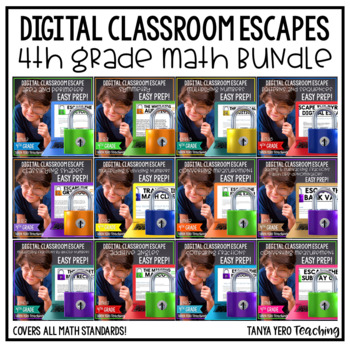Math Digital Escape Room 4th Grade YEARLONG BUNDLE | DISTANCE LEARNING
- Zip
- Google Apps™
- Internet Activities

What educators are saying
Products in this Bundle (28)
showing 1-5 of 28 products
Description
This Math Digital Classroom Escape BUNDLE includes interactive activities which promotes peer collaboration and problem solving. Standards based math questions, challenges, and puzzlers combine to create the perfect blend of learning and fun!
****SAVE 50% OFF BY PURCHASING THE BUNDLE!****
WANT TO TRY OUT A FREE PREVIEW? CHECK OUT THIS FREEBIE ESCAPE CHALLENGE FOR YOUR CLASSROOM! >>>>>>CLICK HERE!!
This Tanya Yero Teaching resource can be used in the classroom and/or for distance learning/ remote learning.
Standards & Topics Covered
Number and Operation in Base Ten
➥ 4.NB.1 - Place Value Concepts
➥ 4.NBT.2 - Number Form, Word Form, Expanded Form, and Comparing of whole numbers
➥ 4.NBT.3 - Rounding multi-digit whole numbers
➥ 4.NBT.4 - Adding & Subtracting Whole Numbers
➥ 4.NBT.5 - Multiplying whole numbers
➥ 4.NBT.6 - Dividing whole numbers
Operations & Algebraic Thinking
➥ 4.OA.1 - Interpreting multiplication equations
➥ 4.OA.2 - Multiplying and dividing word problems
➥ 4.OA.3 - Solving multistep word problems, including interpreting remainders
➥ 4.OA.4 - Factors and multiples, Identifying prime and composite numbers within 100
Number and Operation - Fractions
➥ 4.NF.1 - Equivalent fractions
➥ 4.NF.2 - Comparing fractions
➥ 4.NF.3 - Adding and subtracting fractions with like denominators, decomposing fractions, adding and subtracting mixed numbers with like denominators
➥ 4.NF. 4 - Multiplying a fraction by a whole number
➥ 4.NF.5 - Adding and subtracting fractions with denominators of 10 and 100
➥ 4.NF.6 - Decimal notation for fractions with denominators of 10 and 100
➥ 4.NF.7 - Comparing decimals to hundredths
Measurement and Data
➥ 4.MD.1 - Measurement and converting measurement with the customary and metric systems of length, weight, mass, liquid volume, and time
➥ 4.MD.2 - Solving measurement word problems
➥ 4.MD.3 - Area and perimeter of rectangles
➥ 4.MD.4 - Line plots
➥ 4.MD.5 - Angles within a circle
➥ 4.MD.6 - Measuring angles with a protractor
➥ 4.MD.7 - Additive angle measurement, decomposing angles
Geometry
➥ 4.G.1 - Identifying points, lines, line segments, rays, angles, perpendicular and parallel lines in 2D shapes
➥ 4.G.2 - Classifying 2D figures, types of triangles
➥ 4.G.3 - Symmetry
What is a Digital Classroom Escape?
A digital classroom escape is an interactive activity in which teams of students use clues to solve challenges and unlock “digital locks.” These activities consist of two academic activities aligned to a specific math skill and two puzzlers/ challenges.
What do I need to access these escapes?
You need access to the internet and technology devices. These escapes work on Chromebooks, iPads, and laptops! You DO NOT need a Google account or access to Google Classroom to use Digital Classroom Escapes.
What do I get with this resource?
You will get the link to access your Digital Classroom Escape along with DETAILED teacher directions and tips for every step of the activity. Answer keys and suggestive clues are also provided.
Benefits of a Digital Classroom Escape
➥ EASY PREP! Nothing to print except for teacher directions and tips.
➥ Interactive for students
➥ Immediate student feedback
➥ Practice of a specific math skill
➥ Promotes team building/ peer collaboration
➥ Promotes problem solving skills
➥ Targets technology standards
>>>>>>>>>>>>>>>>>>>>>> PLEASE READ BELOW <<<<<<<<<<<<<<<<<<<<<<
****Want to test out one of our escapes for FREE? CLICK BELOW!****
FREE MATH DIGITAL CLASSROOM ESCAPE
!!! TEST TO SEE IF YOUR DISTRICT BLOCKS THIS SITE FIRST! TRY OUR FREEBIE ESCAPE TO ENSURE THAT THE LINK WILL WORK ON YOUR STUDENTS' TECH DEVICES. I AM NOT RESPONSIBLE IF YOUR DISTRICT BLOCKS THE WEBSITE. IF YOU GET A 404 ERROR THAT MEANS YOUR DISTRICT HAS IT BLOCKED. YOU CAN EMAIL YOUR DISTRICT WITH THE LINK ASKING FOR PERMISSION. IN MOST CASES I HAVE WORKED WITH THE DISTRIST DOES GRANT PERMISSION. !!!





